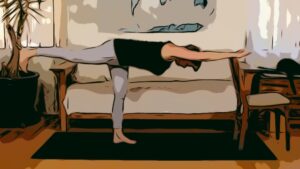Strength stabilizes joints. It increases bone density. And it helps you avoid dislocation. Which means that strength is every Hippie’s best friend.
 When I was preparing for hip replacement, my brother, who had already had both his hips replaced, said “Whatever you do just stay strong!” I was practicing or teaching yoga almost daily (something that I was able to do right up until surgery because yoga is so adaptable) and was already pretty strong. But I took his advice to heart and did a little research to understand why:
When I was preparing for hip replacement, my brother, who had already had both his hips replaced, said “Whatever you do just stay strong!” I was practicing or teaching yoga almost daily (something that I was able to do right up until surgery because yoga is so adaptable) and was already pretty strong. But I took his advice to heart and did a little research to understand why:
- Yoga builds strength and it provides stability for the new joint.
- Yoga increases bone mineral density in the spine, hips, and femurs which is exactly what we want for the strong fusing of the bone to the prosthesis.
- Strength provides stability which helps you avoid dislocation. Poor muscle tension across the hip increases chances of dislocation and…Yoga builds strength!
Don’t wait to build strength. Studies show that strength declines quickly in the weeks following THR surgery making it all the more important to build strength beforehand. As a bonus, yoga not only strengthens the body but it also increases our proprioceptive awareness. “Proprioception” is the body’s ability to tell where it is in space: i.e., where it is in the natural world. Heightened awareness makes us conscious of how we move which in turn helps us avoid accidents.
Make the world your mat. It may not always be possible to pull out your mat to do a half hour strengthening yoga routine. So consider ways you can insert a pose or two into your everyday activities. Do Tree Pose while washing the dishes or practice isometric strengthening by working Mountain Pose into the time you are standing in a grocery line.
Standing Poses preview – Non-members
Standing Poses – Members
Become a Yoga for Hip Replacement Member here
Articles and Studies:
*Twelve-Minute Daily Yoga Regimen Reverses Osteoporotic Bone Loss
Muscular strength after total hip arthroplasty: A prospective comparison of 3 surgical approaches
Changes in Hip and Knee Muscle Strength in Patients Following Total Hip Arthroplasty
Persisting muscle atrophy two years after replacement of the hip
